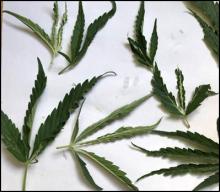By C. M. Ocamb
Cause It is caused by a phytoplasma that is spread by leafhoppers, and the specific phytoplasma involved depends on the region. The dominate type of phytoplasma detected in hemp, including in Oregon, is Beet Leafhopper-transmitted Virescence Agent (BLTVA - group VI), but other types may be present. This disease can affect potato and tomato and also occurs on celery, radish, and Chinese cabbage. The phytoplasma overwinters on weeds or other crop hosts. The disease follows leafhopper migration.
Symptoms A range of symptoms can develop, depending on the phytoplasma involved. Infected plants are typically stunted and have multiple, highly-branched stems due to shoots developing from leaf axils. Leaves may be small, distorted, and chlorotic.
Cultural control
- Control weed hosts.
- Control leafhopper vectors
Chemical control Management of leafhoppers may be warranted under certain conditions. See the PNW Insect Management Handbook for details.
References Raj, S.K., Snehi, S.K., Khan, M.S., and Kumar, S. 'Candidatus Phytoplasma asteris' (group 16SrI) associated with a witches'-broom disease of Cannabis sativa in India. 2008. Plant Pathology 57(6):1173.
Zhao, Y., Sun, Q., Davis, R.E., Lee, I.-M., and Liu, Q. 2007. First report of witches'-broom disease in a Cannabis spp. in China and its association with a phytoplasma of Elm Yellows Group (16SrV). Plant Disease 91(2):227. DOI.org/10.1094/PDIS-91-2-0227C.




